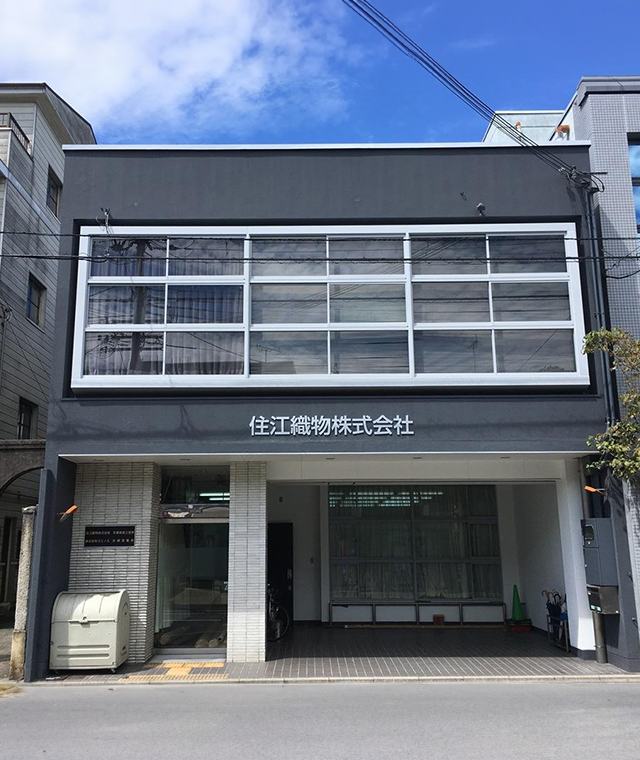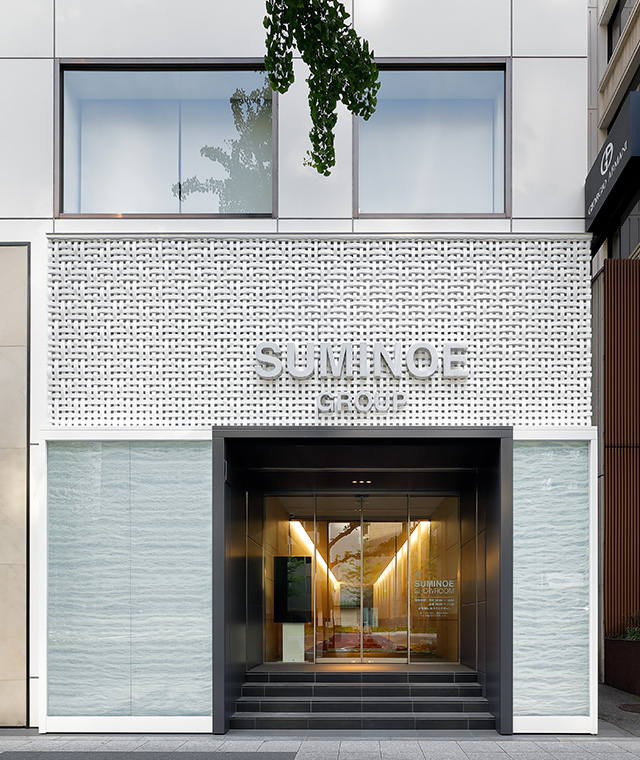- HOME
- 京都美術工芸所概要
京都美術工芸所概要

| 会社名 | SUMINOE株式会社 京都美術工芸所 |
|---|---|
| 所在地 | 〒602-0042 京都府京都市上京区新町通今出川上る元新在家町167-2 TEL 075-414-2545 FAX 075-414-2547 |
| 事業内容 | 西陣織物の企画・製造・販売 緞帳(スミノエアート緞帳・ナッセンジャー緞帳・ジャカード織緞帳地) 別注関連(文化財復元工事・祭幕・懸送品・ホテル関連等のカーテン地・壁装地・椅子張地) 美術工芸織物関連(額・テーブルセンター・風呂敷・各種小物) 団体旗(校旗・略旗・横断幕・のぼり) |
| アクセス | 京都市営地下鉄 烏丸線 今出川駅 4番出口より西へ徒歩約5分 |
本社概要

| 会社名 | SUMINOE株式会社 SUMINOE Co., Ltd. |
|---|---|
| 所在地 | 〒542-8504 大阪市中央区南船場三丁目11番20号 TEL 06-6251-6801 FAX 06-6251-0862 WEBサイト https://suminoe.co.jp/ |
| 創業 | 1883年(明治16年) |
| 資本金 | 95億5千4百万円(2024年5月31日現在) |
| 代表者 | 代表取締役社長 永田 鉄平 |
| 従業員数 | 258名(連結グループ2,812名)(2024年5月31日現在) |
| 事業内容 | インテリア事業(カーペット、カーテン、壁紙、各種床材など) 自動車・車両内装事業(自動車・バス・鉄道車両等の内外装材) 機能資材事業(電気カーペット、消臭関連商材、航空機の内装材など) |
ごあいさつ
Message
伝統織物の流れを受け継ぎ、その熟達の技と心で織り上げております。
SUMINOE GROUPの美術工芸織物は、その源を遠く平安の昔にさかのぼる伝統織物の流れを汲み、長い歴史の日々に培われた織物技術と、新しい時代の感覚と技法を織り混ぜながら磨かれてまいりました。特に近年では、舞台装飾織物、織物壁紙、敷物等、美術織物の製作に心血を注ぎ、その芸術の香り高い作品は、各方面から高い評価を頂いております。
今後も一意専心努力に励み、美術工芸的価値のある作品を創造してまいりますので、なお一層のご愛顧ご鞭撻のほどお願い申し上げます。
SUMINOE株式会社 インテリア事業部門
部門長 村瀬典久
美術織物の沿革
日本民族のもつすぐれた美意識は、わが国固有の文化を生み育てたばかりでなく、時代の要求と共に滔々と流れ込んだ東西の諸文化を、吸収し、消化し、巧みに自己の中に織り込んで、独特の民族文化を形成しました。わが国の織物文化は、奈良時代に仏教と共に導入された、世界国家的スケールをもつ隋・唐の文化により、一挙に高度化し、遂に織物を美術工芸の域にまで到達させました。
その後、平安遷都に従って京都に移ることとなった染織産業は、西陣に定着し、時の最高技術者秦氏を中心とする産業組織が形成され、次第にその周辺にも自由な民間の織物業者たちの輪が拡がり、西陣を日本の織物の中心としたのです。
弊社は、こうした由緒ある西陣の宮廷織物所の一つを前身として、古くは宮中、諸大名のご用命を承り、近くは宮内庁御用達として、天皇、皇后、皇太子、皇太子妃の各御旗をはじめ、御大典調度品などの製織にご奉仕する栄誉を賜っています。
創業以来、室内装飾織物の専門メーカーとして、緞帳、緞通などの美術織物の創作に伝統の火を燃やし続ける一方、また新しい技術への挑戦に怠りない弊社は、外国からの技術、機械を導入して、各種カーペット、椅子張地、カーテン地、壁装地など、次第に事業内容を拡げ、戦前既に、紡毛から染色、製織、仕上げに至る迄一貫工程をもつ、名実共に室内装飾織物のトップメーカーとなりました。
近年では、生活の質的向上をめざす社会のニーズに対応して、特に美術織物の創作に力を注ぎ、昭和43年に完成した新宮殿には当社の技術を結集して、豊明殿の手織緞通、正殿の壁張地をはじめ新宮殿を飾る大部分の織物を製作したほか、衆参両院など我が国を代表する格式高い建造物の内装に伝統織物の真髄を披歴しております。
History of Artistic Textiles
The Japanese people, with their excellent artistic talent, have formed an original culture not only by developing indigenous cultural elements, but by deftly assimilating many foreign cultural elements, originating both in the West and the East, which streamed into their country in different ages. The techniques of dyeing and weaving also made great progress in Japan in the Nara era (710-784) under the influence of Chinese culture in the Sui and T'ang periods, during which China expanded into a world power. Thus, Japanese textiles reached a high artistic standard in this era, during which Buddhism was also introduced to Japan.
After the designation of Kyoto as Japan's new capital, craftsmen specializing in dying and weaving settled in the Nishijin district of the city to serve the Emperor's court. They formed a well-organized community led by members of the House of Hata, who possessed the then unrivaled expertise in this field. The community gradually expanded by absorbing commercial textile manufacturers, making Nishijin the center of textile industry in Japan.
The ancestor of our company is a textile factory in Nishijin founded by the Emperor's court, which served noblemen and feudal lords. Thanks to its distinguished tradition, our company has been enjoying the honor of being designated as supplier to the Imperial Household Agency. In this capacity, we have manufactured banners for Emperors, Empresses, Princes Imperial and Crown Princesses, as well as requisites for Imperial ceremonies.
Since its founding, our company, as a manufacturer of textiles for interior decoration, has been producing drop curtains, hand-woven carpets and other artistic textiles, in which our precious heritage is fully utilized. As well, we have been constantly exploring new technical fields, introducing techniques and machinery from overseas. As a result, the range of our products has expanded to include various carpets, and cloths for chairs, curtains and walls. Before World War II, our company established its status as leading manufacturer of textiles for interior decoration, both in name and reality, with a comprehensive production system comprising woollen spinning, dyeing, weaving and finishing.
In recent years, our company is devoting much of its efforts to the production of artistic textiles, in response to the social trends toward the improvement of the quality of life. During the construction of the new Emperor's Palace, which was completed in 1968, we brought our technical expertise into full play to manufacture most of the textiles decorating the Palace, including the handwoven carpet in the Homeiden Building and the wall cloth in the Seiden Building. As well, our company has produced excellent traditional textiles, which decorate the interiors of the House of Representative, the House of Councilors and other stately buildings in Japan.
We are making constant efforts to open new artistic dimensions of textile, while proudly keeping old Japanese tradition alive.

